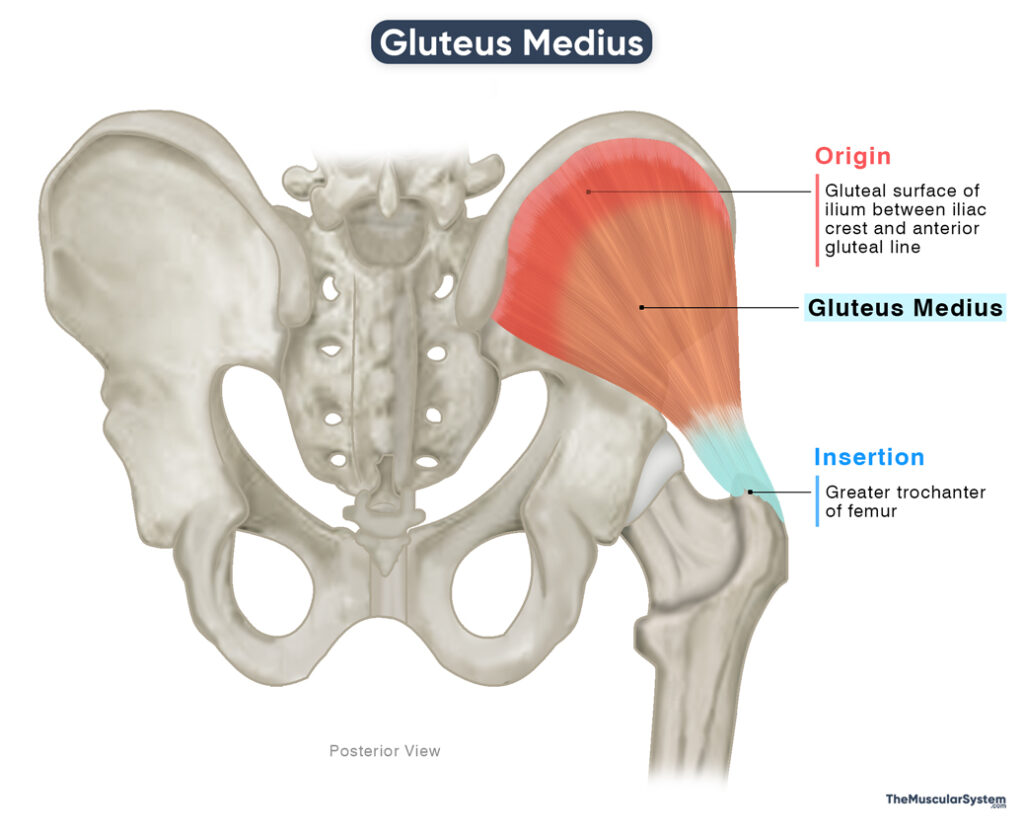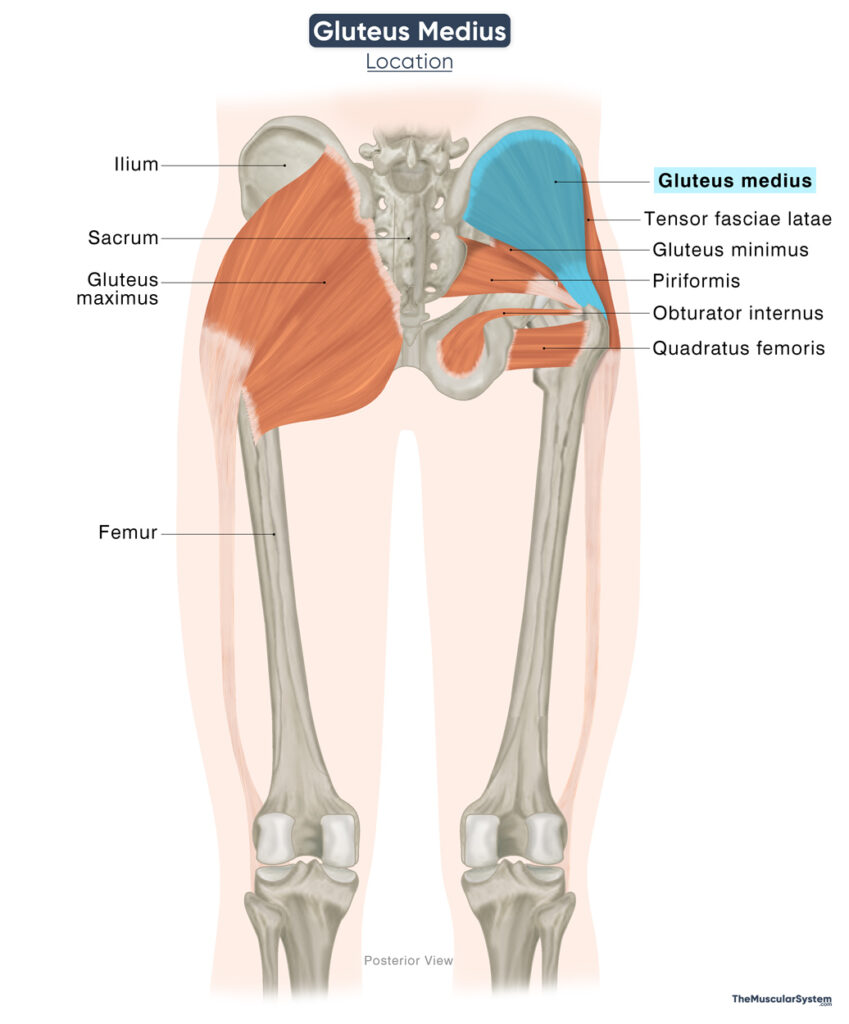Gluteus Medius
Last updated:
14/08/2025Della Barnes, an MS Anatomy graduate, blends medical research with accessible writing, simplifying complex anatomy for a better understanding and appreciation of human anatomy.
What is the Gluteus Medius
The gluteus medius is a large, radiating or fan-shaped muscle located on the lateral and posterior sides of the top of the buttocks. It is one of the three gluteal muscles, along with the gluteus maximus and gluteus minimus.
This muscle plays a key role in movements of the hip joint, acting as one of the main abductors and internal rotators of the thigh. It also helps stabilize the pelvis and hip joint during movement.
Anatomy
Location and Attachments
| Origin | The gluteal surface of the ilium, from the iliac crest, and between the posterior and anterior gluteal line |
| Insertion | Greater trochanter of the femur |
Origin
The muscle originates from a broad area on the gluteal surface of the ilium, extending from the iliac crest down to the region between the posterior and anterior gluteal lines. The gluteal aponeurosis that covers the gluteus medius muscle also serves as the point of origin for part of the muscle.
Insertion
The muscle fibers converge from a broad, fan-shaped belly into a flattened, narrow tendon that inserts on the greater trochanter of the femur.
- The posterior fibers run downward and forward to attach to the superoposterior surface of the greater trochanter.
- The anterior and middle fibers run more vertically and slightly posteriorly to insert on the lateral surface of the greater trochanter.
The two distinct points of insertion allow the posterior and the anteromedial fibers of the gluteus medius to perform specialized actions.
Relations With Surrounding Muscles and Structures
The gluteus medius is one of the superficial muscles of the gluteal or buttock region. As its name suggests, it lies between the other two gluteal muscles, with the gluteus maximus lying superficially, and the gluteus minimus lying deep to it.
The posterior and lower parts of the gluteus medius are covered by the gluteus maximus, while its upper and lateral portions remain exposed. These exposed parts are covered by the deep fascia of the hip, often referred to as the gluteal fascia, which is continuous with the fascia lata of the thigh. Inferior and deep to the gluteus medius is the piriformis, whereas the tensor fasciae latae occupies an anterior and slightly lateral position.
A bursa lies between the muscle’s tendon and the greater trochanter, allowing the tendon to glide smoothly over the bone. Inflammation or damage to this bursa can result in trochanteric bursitis, which causes pain and tenderness over the lateral hip.
The superior gluteal artery and nerve course along the deep surface of the gluteus medius, between it and the gluteus minimus.
Function
| Action | Abducting and internally rotating the thigh at the hip joint; stabilizing the pelvis and hip |
Although the gluteus maximus is often thought to be the most important muscle in the buttocks region, the truth is that the gluteus medius is in no way any less important. It plays a vital role in the movement and stability of the hip joint and is one of the most important muscles in walking. It works in synergy with the gluteal minimus in all its functions, which include:
1. Abducting the thigh
It is one of the primary abductors of the thigh at the hip joint, working with the gluteus minimus and tensor fascia latae. When it contracts, it pulls on the greater trochanter of the femur, thus abducting the thigh, which means moving the thigh away from the body’s midline, like when stepping sideways.
2. Rotating the thigh medially
Since the anterior and posterior fibers of the muscle can contract separately, the anterior fibers have a distinct action. When they contract, they pull on the greater trochanter in a way that medially (internally) rotates the thigh, as when turning the toes toward the opposite foot.
3. Stabilizing the pelvis and hip joint
Another vital function of this muscle is stabilizing the hip region and preventing the pelvis from dropping on the opposite side during walking or other movements where the body’s weight shifts to one leg.
When one foot is off the ground during walking (the swing phase of the gait cycle), the weight of the body is supported by the weight-bearing leg, while the pelvis on the unsupported side tends to tilt downward under the body’s weight. The gluteus medius, together with the gluteus minimus on the supporting side, exerts a strong pull on the ilium, keeping the pelvis level. This action is crucial for maintaining pelvic stability, not just during walking, but also while running, climbing stairs, and participating in sports.
Antagonists
As one of the primary hip abductors, its main antagonists are the hip adductors, which bring the thigh toward the midline. These include the adductor longus, adductor brevis, adductor magnus, gracilis, and pectineus muscles.
Additionally, the lateral rotator group, comprising muscles such as the piriformis, obturator internus, obturator externus, and quadratus femoris, acts against the gluteus medius when it medially rotates the thigh.
Innervation
| Nerve | Superior gluteal nerve (L4-S1) |
Its innervation comes from the superior gluteal nerve, which rises from the posterior branches of the 4th-5th lumbar (L4-L5) and 1st sacral (S1) nerves of the sacral plexus.
Blood Supply
| Artery | Superior gluteal artery |
The primary blood supply to the muscle comes from the superior gluteal artery, a terminal branch of the internal iliac artery’s posterior division.
Additionally, around its insertion on the greater trochanter, it receives vasculature from the trochanteric anastomosis, which also supplies the femoral head. This anastomosis is formed by the superior and inferior gluteal arteries, along with the ascending branches of the lateral and medial circumflex femoral arteries.
References
- Anatomy, Bony Pelvis and Lower Limb, Gluteus Medius Muscle: NCBI.NLM.NIH.gov
- Gluteus Medius Muscle: Elsevier.com
- Gluteus Medius Muscle: Kenhub.com
- Gluteus Medius: TeachMeAnatomy.info
- Gluteus Medius Muscle: IMAIOS.com
- Muscles of the Gluteal Region: TeachMeAnatomy.info
Della Barnes, an MS Anatomy graduate, blends medical research with accessible writing, simplifying complex anatomy for a better understanding and appreciation of human anatomy.
- Latest Posts by Della Barnes, MS Anatomy
-
Thyrohyoid
- -
Suprahyoid Muscles
- -
Geniohyoid
- All Posts







